九岭成矿带位于赣西北部地区,是江西省重要的钨、锡、金成矿区之一。九岭花岗岩体是我国华南一个规模巨大的复式岩基,是晋宁期和燕山期多期次岩浆侵入活动的产物。区内燕山期花岗岩主要由中细粒黑云母花岗岩、白云母花岗岩以及少量的二云母或白云母花岗岩、花岗斑岩、石英斑岩等组成。由于缺乏年代学测定或者已有的测定结果存在争议,对该套燕山期杂岩体至今还未能建立起较为系统的构造岩浆年代学格架,关于区内燕山期岩浆活动开始的时间也存在争议。江西省地质矿产局(1984)利用黑云母K-Ar法测得古阳寨北侧的黑云母花岗岩年龄值为177Ma,因此认为是燕山早期的产物。林黎等(2006a, b) 获得大湖塘矿区燕山期岩浆岩的黑云母K-Ar同位素年龄在134~150Ma,并将燕山期岩浆活动划分为多个阶段,但是文中只给出两个同位素年龄,缺乏详细的分析测试过程。钟玉芳等(2005)开展了锆石SHRIMP U-Pb年龄测定,得出九仙塘中细粒黑云母花岗岩的年龄为151.4±2.4Ma。然而,对区内的与成矿关系密切的似斑状白云母花岗岩的年代学研究还未有报导。
江西武宁大湖塘钨矿床属于九岭成矿带西段,位于赣西北部地区,目前已探明钨金属储量106万吨,成为世界最大钨矿之一。大湖塘钨矿是多类型矿化紧密共生的岩浆-热液型钨矿床,成矿围岩主要为晋宁期的九岭花岗闪长岩和由燕山期多次侵入的中细粒黑云母花岗岩、白云母花岗岩以及花岗斑岩等杂岩体组成。前人对该地区的矿床地质特征和矿床成因方面研究较少,主要认为该矿床具有多期次的成矿特点。尽管大湖塘钨矿成矿与燕山期酸性浅成侵入岩体关系密切,但对这些侵入岩的地质地球化学研究还很少,远不如华南中生代其他钨锡矿床的研究程度(Wang et al., 2010; Feng et al., 2011; Shu et al., 2011; 梅勇文, 1987; 许建祥等,2008;王旭东等,2008;程彦博等, 2010; 华仁民等,2010;丰成友等, 2007, 2011, 2012a, b)。本文对大湖塘钨矿成矿母岩似斑状白云母花岗岩开展了详细的锆石U-Pb定年工作、云母矿物化学、全岩主微量元素与Sr-Nd同位素组成的研究工作,探讨白云母花岗岩的成岩年龄、岩石成因、构造背景及成矿意义。
1 地质背景及岩石学特征江西省大湖塘钨(钼、铜、锡) 矿集区位于江南造山带中段,九岭山脉中段北部之武宁、修水、靖安三县交界区域,面积约750km2。本区地处扬子古板块东南缘,隶属Ⅱ级构造单元江南地块之九岭-障公山隆起西段,南邻萍-乐坳陷,北为修水-武宁滑覆拗褶带,东邻鄱阳湖坳陷(图 1)。区域构造位于赣北东西向构造带的九岭-官帽山复式背斜与武宁-宜丰北北东向走滑冲断-伸展构造的复合部位,属九岭北北东向钨钼铜多金属成矿带的中部(林黎等, 2006b)。
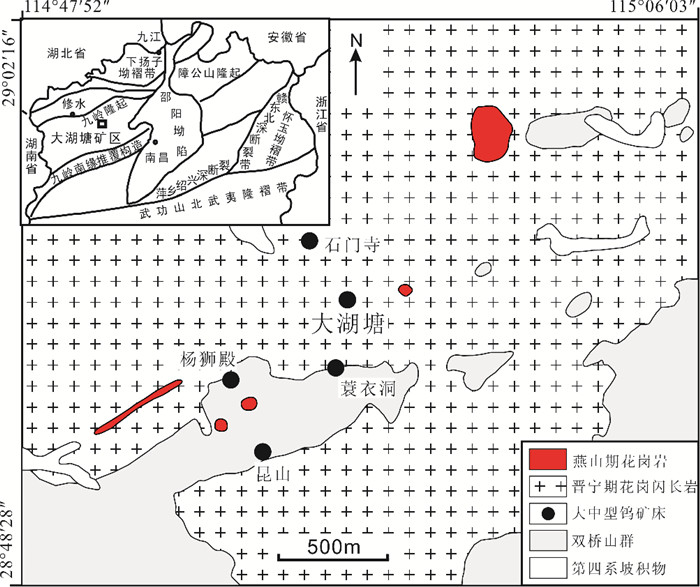
|
图 1 江西北部大湖塘钨矿区地质简图 Fig. 1 Simplified geologic map of Dahutang tungsten ore area in northern Jiangxi Province |
区域地层为双桥山群浅变质岩,为一套巨厚的绿片岩相浅变质浊流沉积,成分以泥砂质沉积岩为主,局部夹少量火山岩(江西地质矿产局, 1984)。双桥山群一直以来被认为是中元古代(江西地质矿产局, 1984;杨明桂等, 1988; 马长信, 1991), 但最新研究结果表明双桥山群为新元古代地层(Wang et al., 2008; 高林志等, 2008, 2012)。区内大面积出露晋宁期中-粗粒黑云母花岗闪长岩以及燕山期的似斑状二云母或白云母花岗岩、中细粒黑云母花岗岩以及花岗斑岩等。晋宁期花岗岩呈岩基产出,燕山期花岗岩呈小岩株、岩瘤或岩墙(脉) 产出(林黎等, 2006a) (图 1)。燕山期岩体侵入于双桥山群浅变质的砂页岩中。
大湖塘矿区内燕山期岩浆岩具多期次侵入特征,岩浆活动可分为三个阶段(林黎等, 2006a)。燕山期首次侵入体岩性主要为中-细粒黑云母花岗岩、似斑状二云母或白云母花岗岩,岩体多呈岩株(瘤)、岩枝(脉) 产出。燕山期第二次侵入体岩性主要为二云母或白云母花岗岩、黑云母花岗斑岩,多呈岩墙(脉) 产出,局部地段由于岩浆在结晶、冷凝过程中,主体挥发组份聚集,压力增大,发生隐爆,形成隐爆角砾岩。燕山期第三次侵入体岩性为花岗斑岩(或石英斑岩),呈岩脉(墙) 状,与黑云母花岗斑岩脉(墙) 几乎平行产出。
大湖塘矿集区是以细脉浸染型黑(白) 钨矿为主体,兼有石英大脉型,蚀变花岗岩型、云英岩型及隐爆角砾岩型钨(钼、铜) 矿等共生的矿床。区内矿床属与燕山期花岗岩浆热液有关的钨钼铜成矿系列,矿体环绕燕山早期花岗岩株顶部及外接触带形成“多位一体”的钨(钼、铜) 矿床,矿体多分布于石英大脉、石英细(网) 脉及花岗岩体中,部分浸染于脉侧围岩中,形成脉状和“面型”或带状矿化。
本文选取了来自大湖塘矿床狮尾洞矿区0线钻孔不同深度的三块似斑状白云母花岗岩样品:ZK0-26-1、ZK0-26-2、ZK0-26-3。岩石呈块状构造,似斑状结构,斑晶多由石英、长石组成。主要矿物组成有斜长石(25%~33%)、钾长石(22%~26%)、石英(30%~36%)、白云母(5%~10%) 以及少量黑云母(2%), 副矿物见钛铁矿、磁铁矿等,基质具花岗结构, 岩石的典型结构构造如图 2所示。
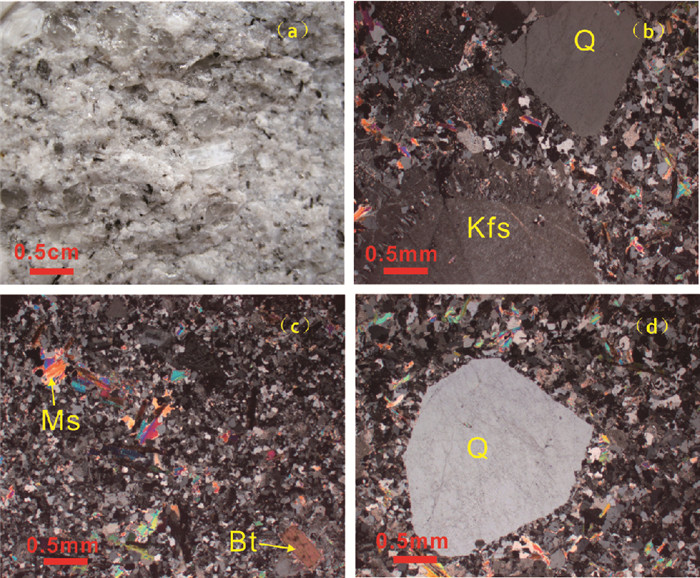
|
图 2 大湖塘似斑状白云母岩石标本和显微照片 (a)-似斑状白云母花岗岩手标本;(b-d)-似斑状白云母花岗岩显微照片,正交偏光.Kfs-钾长石Q-石英;Ms-白云母;Bt-黑云母 Fig. 2 Photos and microphotographs of the Dahutang porphyric-like muscovite granite (a)-hand specimen of porphyric-like muscovite granite; (b-d)-microphotographs of porphyric-like muscovite granite, CPL. Kfs-potassium feldspar; Q-quartz; Ms-muscovite; Bt-biotite |
用于锆石U-Pb年代学测试的似斑状白云母花岗岩(样品ZK0-26-3) 首先经过破碎,经浮选和电磁选等方法后,挑选出单颗粒锆石。将锆石颗粒用环氧树脂固定于样品靶上。样品靶表面经研磨抛光,直至磨至锆石晶体近中心截面。对靶上锆石进行镜下透射光、反射光照相后,对锆石进行阴极发光(CL) 分析,锆石CL实验在北京锆年领航科技有限公司的实验室拍摄,根据阴极发光照射结果选择典型的岩浆锆石进行锆石U-Pb测年分析。锆石U-Pb定年工作在南京大学内生金属矿床成矿机制研究国家重点实验室采用LA-ICP-MS完成,ICP-MS型号为Agilent 7500a型,激光剥蚀系统为New Wave公司生产的UP213固体激光剥蚀系统。质量分馏校正采用标样GEMOC/GJ-1(608 Ma),每轮(RUN) 测试约分析15个分析点,开始和结束前分别分析GJ-1标样2~4次,中间分析未知样品10~12次,其中包括1次已知年龄的锆石样品Mud Tank (735Ma)。测试过程中激光束斑的剥蚀孔径为25μm,剥蚀时间60s,背景扫描时间40s,激光脉冲重复频率5Hz,采集206Pb,207Pb,208Pb,232Th和238U的计数来测定年龄。实验原理和详细的测试方法见(Jackson et al., 2004)。ICP-MS的分析数据通过即时分析软件GLITTER (Van Achterbergh et al., 2001) 计算获得同位素比值、年龄和误差。普通铅校正采用(Andersen, 2002) 的方法进行校正,结果用Isoplot程序(V.3.23) 完成年龄计算和谐和图的绘制(Ludwig, 2003)。
将所取得的三块样品进行岩石地球化学分析。首先将样品破碎、磨碎(200目) 制成分析样品。主量元素、微量元素和Sr、Nd同位素均在南京大学内生金属矿床成矿机制研究国家重点实验室完成。其中主量元素运用XRF完成;微量元素运用ICP-MS测定(型号为Finnigan Element Ⅱ),详细的分析方法参考(高剑峰等, 2003);Sr、Nd同位素采用BioRad AG 50W×8阳离子树脂纯化Sr、Nd元素,详细的化学分离流程参考(濮巍等, 2005)。提纯后的样品用TIMS (型号为Finnigan Triton TI) 分析测试Sr和Nd同位素比值,测试过程中采用86Sr/88Sr=0.1194, 146Nd/144Nd=0.7219校正质量分馏。
样品中黑云母和白云母的矿物化学组成利用南京大学内生金属矿床成矿机制研究国家重点实验室的JEOL JXA-8100M型电子探针进行测试。工作条件为:加速电压15kV,探针电流10nA,束斑直径1μm;定量分析的标样均为美国国家标准局的矿物标样。
3 分析结果 3.1 矿物化学对大湖塘似斑状白云母花岗岩样品ZK0-23-2的白云母、黑云母成分进行了电子探针分析,分析结果及以22个氧原子为基础计算得出白云母、黑云母晶体化学式和有关参数,具体结果见表 1。大湖塘似斑状白云母花岗岩黑云母具有富铁贫镁高钛的特点,Fe/(Fe+Mg) 为0.70~0.78,TiO2含量为3.02%~4.22%。运用郑巧荣(1983)的方法计算黑云母中的FeO和Fe2O3的含量,得出FeO含量变化范围20.77%~22.61%,远高于Fe2O3的含量0.41%~1.06%,表明本区黑云母结晶时的环境是偏还原性的。样品的F含量较高,变化范围在1.01%到1.22%之间。将黑云母成分数据投于分类图解图 3中(Rieder et al., 1998),所有数据都位于铁云母区域内,介于羟铁云母与铁叶云母之间。在Abdel-Rahman (1994)的黑云母Al2O3-FeOT-MgO分类图解(图 4) 上,所有数据点都落入了P区,表明它们属于过铝质花岗岩。张玉学(1982)和周作侠(1988)认为黑云母的成分与其成岩物质的来源有关系,富铁质黑云母的成分指示着成岩物质来源于上地壳。大湖塘似斑状白云母花岗岩的黑云母在FeOT/(FeOT+MgO) 与MgO关系图(图 5) 中分布在Ⅲ地壳区域,说明其成岩物质来源于上地壳。
|
|
表 1 大湖塘似斑状白云母花岗岩中黑云母-白云母化学组成(wt%) 与结构计算 Table 1 Representative electron microprobe analyses (wt%) and structural formula of biotite and muscovite from the Dahutang porphyric-like muscovite granite |
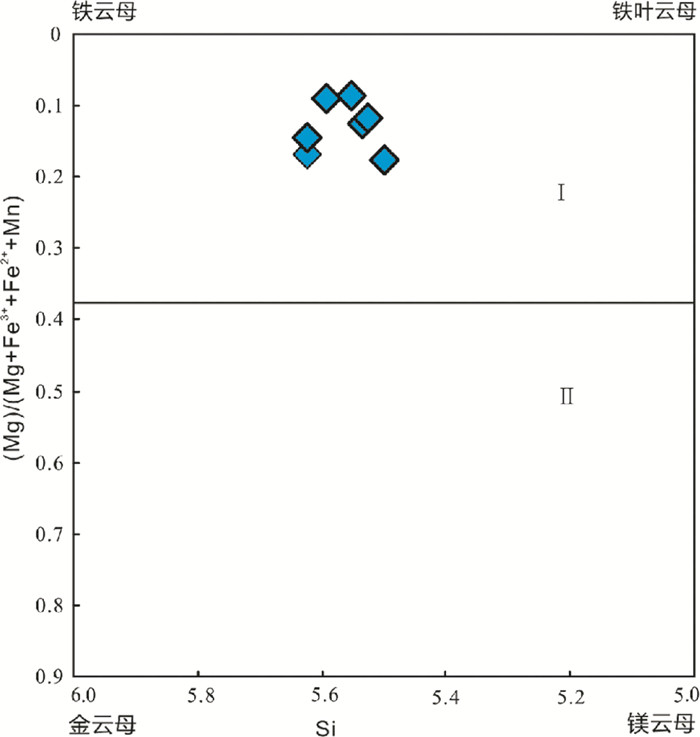
|
图 3 大湖塘似斑状白云母花岗岩黑云母分类图(底图据Rieder et al., 1998) Fig. 3 Classifieation of biotites from the Dahutang porphyric-like muscovite granite (after Rider et al., 1998) |

|
图 4 大湖塘似斑状白云母花岗岩黑云母FeOT-Al2O3-MgO图解(底图据Abdel-Rahman, 1994) A-非造山带碱性花岗岩; P-过铝质花岗岩; C-造山带钙碱性花岗岩 Fig. 4 Plot of FeOT-Al2O3-MgO of biotites from Dahutang porphyric-like muscovite granite (after Abdel-Rahman, 1994) |
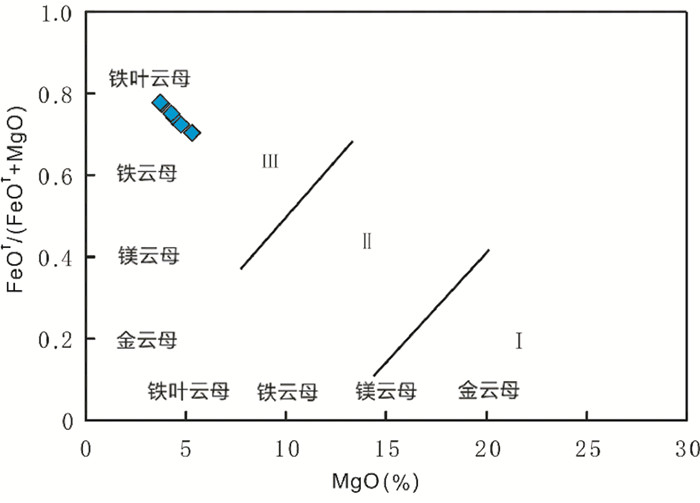
|
图 5 大湖塘似斑状白云母花岗岩黑云母成分与物质来源相关图(底图据张玉学,1982) Ⅰ-幔源区; Ⅱ-壳幔混合区;Ⅲ-壳源区 Fig. 5 Relationship between the composition of biotite from the Dahutang porphyric-like muscovite granite and the source regions (after Zhang, 1982) |
白云母属于强过铝的矿物,是强过铝质花岗岩的指示矿物(Clarke, 1981)。样品中白云母SiO2含量变化为44.46%~46.13%,FeOT含量为2.02%~3.20%。FeT/(FeT+Mg) 比值为0.59~0.61,Na原子数的范围是0.131~0.184,Al原子数总和为5.509~5.651,显示原生白云母的特征(孙涛等, 2002)。图 6中,本区样品都投影在原生白云母区域;结合图 2b-d所示,白云母有可能在岩浆结晶晚期与基质中的长石、石英一起结晶。
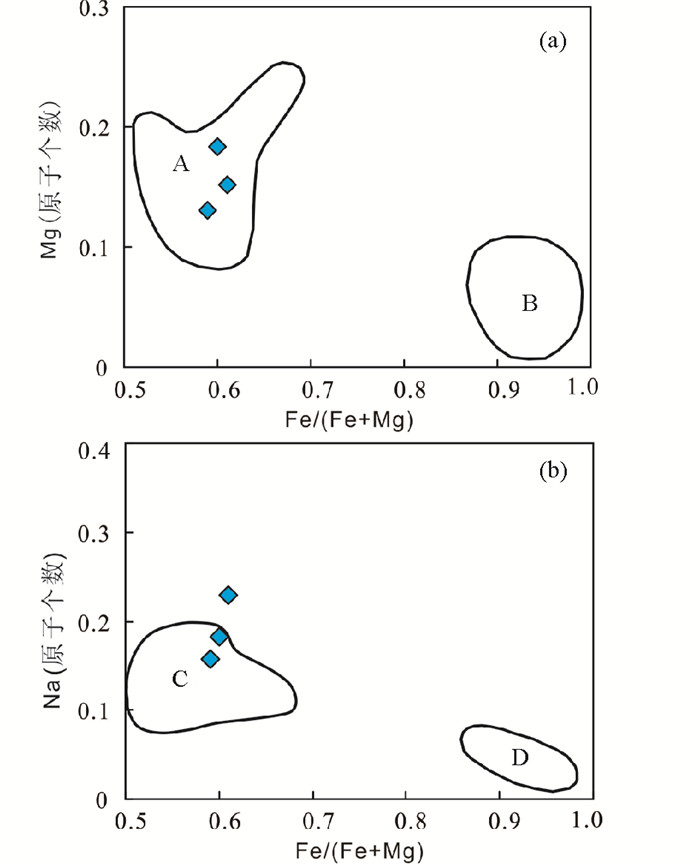
|
图 6 大湖塘似斑状白云母花岗岩中白云母成分图解 (a)-Mg-Fe/(Fe+Mg); (b)-Na-Fe/(Fe+Mg) 图解. A、C区-原生白云母投影区(孙涛等, 2002);B、D区-次生白云母投影区(孙涛等, 2002) Fig. 6 Plots of Mg-Fe/(Fe+Mg) (a) and Na-Fe/(Fe+Mg) (b) of muscovite from the Dahutang porphyric-like muscovite granite Area of A, C-field of primary muscovite defined by Sun et al. (2002); area of B, D-field of secondary muscovite defined by Sun et al. (2002) |
大湖塘似斑状白云母花岗岩样品ZK0-26-3中锆石为无色透明或浅黄色,大部分锆石结晶较好,呈长柱状晶形。在阴极发光(CL) 图像上,锆石具明显的内部结构和典型的岩浆振荡环带,样品中也有部分锆石CL图像中呈黑色,环带不明显(图 7a),与该锆石中U、Th含量很高相对应(表 2)。样品ZK0-26-3锆石共分析了29个点(表 2),这些锆石的U含量的变化范围在460×10-6~657857×10-6之间,Th的变化范围在65×10-6~231958×10-6之间, Th/U比值变化范围在0.10~1.36之间,均大于0.1(点ZK12、ZK24、ZK26、ZK27除外)。点ZK12的206Pb/238U年龄为308Ma,207Pb/235U年龄为310 Ma,207Pb/206Pb年龄为325Ma,Th/U比值为0.02;点ZK26的206Pb/238U年龄为400Ma,207Pb/235U年龄为402Ma,207Pb/206Pb年龄为421Ma,Th/U比值为0.05,表明它们均可能是岩浆上升过程从围岩捕获的变质锆石。锆石点ZK1、ZK 2、ZK 7、ZK 9、ZK 12、ZK15、ZK 16、ZK 17、ZK 25、ZK 26、ZK 29得出了较老的年龄值,206Pb/238U年龄分别为813Ma、1293Ma、308Ma、156Ma、733Ma、400Ma和767Ma等); 此外,样品中的部分点ZK3、ZK6、ZK11、ZK18、ZK20、ZK22因测得的年龄不在谐和线上,这几个点在计算年龄时均未统计在内。其余11个点的年龄比较一致,206Pb/238U年龄变化在142~148Ma之间,也全落在U-Pb年龄谐和图上(图 7a),计算得到的加权平均年龄为144.2±1.3Ma (n=11, MSWD=1.3)(图 7b),这个年龄应代表了大湖塘似斑状白云母花岗岩的结晶年龄。
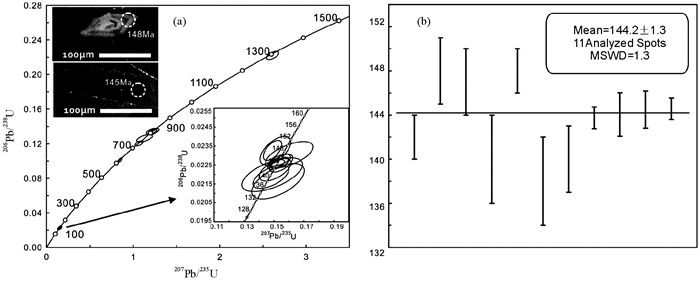
|
图 7 大湖塘似斑状白云母花岗岩ZK0-26-3样品的锆石U-Pb年龄图及谐和图 Fig. 7 Zircon U-Pb age and its concordia diagram of sample ZK0-26-3 from the Dahutang porphyric-like muscovite granite |
|
|
表 2 大湖塘似斑状白云母花岗岩(样品Zk0-26-3) 的LA-ICP-MS锆石U-Pb年龄测定结果 Table 2 LA-ICP-MS zircon U-Pb dating results of sample Zk0-26-3 from Dahutang porphyric-like muscovite granite |
对大湖塘似斑状白云母花岗岩的三个样品ZK0-26-1、ZK0-26-2、ZK0-26-3进行了主量元素和微量元素含量的测定,分析结果见表 3。从表 3中可看出,大湖塘似斑状白云母花岗岩在主量元素组成上具有富硅富碱的特征,SiO2含量变化是72.88%~73.33%;K2O+Na2O为7.69%~8.09%,且相对富钾。大湖塘似斑状白云母花岗岩的A/CNK为1.16~1.24,表明岩体属于强过铝质花岗岩(图 8)。
|
|
表 3 大湖塘似斑状白云母花岗岩主量元素(wt%) 和微量、稀土元素(×10-6) 分析结果 Table 3 Major elements compositions (wt%) and trace and rare earth elements compositions (×10-6) of the Dahutang porphyric-like muscovite granite |

|
图 8 大湖塘似斑状白云母花岗岩的A/CNK-A/NK图 Fig. 8 Plot of A/CNK-A/NK from the Dahutang porphyric-like muscovite granite |
三个样品的稀土元素组成特征总体表现为稀土总量较低,ΣREE变化于113×10-6到124×10-6之间。在球粒陨石标准化的稀土元素配分模式图上(图 9a),稀土元素表现出右倾斜的配分特征。总体上样品富集轻稀土,LREE/HREE为9.88~11.7,(La/Yb)N值高(15.1~19.0),变化范围不大,属于轻稀土富集,轻重稀土分馏强烈,并且具有强烈的Eu负异常,Eu/Eu*为0.13~0.24。
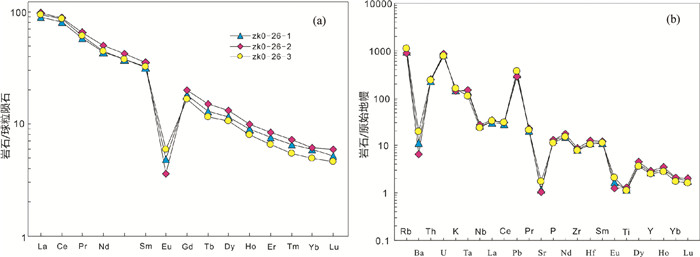
|
图 9 大湖塘似斑状白云母花岗岩稀土元素分布模式图(a) 和原始地幔标准化微量元素蛛网图(b)(标准化值据McDonouch and Sun, 1995) Fig. 9 Chondrite-normalized REE patterns (a) and primitive mantle-normalized trace element patterns (b) of representative samples of the Dahutang porphyric-like muscovite granite (normalization values after McDonough and Sun, 1995) |
在微量元素蛛网图(图 9b) 中,大湖塘似斑状白云母花岗岩的微量元素分布较为一致,都表现出富集Rb、U、Th、Pb等大离子亲石元素,贫Ba、Nb、Sr、Ti、Eu。Nb负异常是大陆地壳的特征,指示了地壳物质参与了岩浆过程。此外,花岗岩具典型的低Ba-Sr高Rb花岗岩的特征,Rb/Sr高,变化范围在19~26之间,表明岩浆物质以壳源为主,显示了陆壳重熔花岗岩的特征。
3.4 Sr-Nd同位素大湖塘似斑状白云母花岗岩样品的Sr-Nd同位素分析及计算结果见表 4。由于样品具有较高的Rb含量和较低的Sr含量,Rb、Sr含量的测试误差, 年代学的测试误差, 及岩石形成后随时间演化87Rb衰变成87Sr的地质过程等均会对样品的87Sr/86Sr的初始值计算具有较大的影响。本次计算得到三个岩石样品的(87Sr/86Sr)i值两个均 < 0.7(表 4),因此我们认为这些Sr同位素初始值数据不能使用。计算得到的εNd(t) 值变化范围很小,在-7.47~-7.78之间,利用两阶段模式(Liew and Hofmann, 1988) 计算出的Nd同位素模式年龄tDMC为1543~1568Ma。
|
|
表 4 大湖塘似斑状白云母花岗岩Rb-Sr和Sm-Nd同位素组成 Table 4 Rb-Sr and Sm-Nd isotopic compositions of the Dahutang porphyric-like muscovite granite |
前人用白云母K-Ar法测九岭地区甘坊岩体年龄为257Ma和204Ma (江西省地质矿产局, 1984),黑云母K-Ar法测得古阳寨北侧的黑云母花岗岩年龄为177Ma,大湖塘矿区燕山期岩浆岩的黑云母K-Ar同位素年龄在134~150Ma (林黎等, 2006a, b),并将大湖塘燕山期岩浆活动划分为燕山早期第三阶段、燕山晚期第一阶段和燕山晚期第三阶段。可见关于九岭地区燕山期岩浆活动的年代学格架还很不完善并且存在争议。九岭地区燕山期岩浆活动早期形成的花岗岩主要是黑云母花岗岩和白云母或二云母花岗岩。钟玉芳等(2005)利用锆石SHRIMP U-Pb定年方法测得九仙塘燕山期中细粒黑云母花岗岩的年龄为151.4±2.4Ma,这个年龄是比较可信的。而本文对九岭大湖塘地区的似斑状白云母花岗岩开展了锆石LA-ICP-MS U-Pb定年工作,获得的206Pb/238U加权平均年龄为144.2±1.3Ma,代表了白云母花岗岩的形成年龄。这一白云母花岗岩按照岩体的穿插关系,显示为较早期侵入的花岗岩。这一白云母花岗岩的定年结果,结合九仙塘黑云母花岗岩的形成年龄为151.4±2.4Ma,表明九岭地区燕山期岩浆活动的开始时间应该为侏罗纪和白垩世交接的时段。
4.2 花岗岩的岩石成因类型大湖塘似斑状白云母花岗岩样品的SiO2含量变化是72.88%~73.33%;碱含量较高(K2O+Na2O=7.69%~8.09%),且相对富钾。A/CNK值为1.16~1.24,属于强过铝质花岗岩。微量元素中,稀土总含量不高,配分模式呈右倾型,轻重稀土分馏明显,有强烈的铕负异常,Rb/Sr值很高(19~26),并且亏损Nb、Ta等高场强元素。这些地球化学特征与典型强富铝的华南壳源型花岗的地球化学特征基本相同(孙涛等, 2002, 2003; 王孝磊等, 2004; 周新民, 2007)。在ACF三角图解(图 10) 中,样品点全投影在S型花岗岩的强过铝质区域。根据Watson and Harrison (1983)提出的锆饱和温度计,计算出岩石的成岩温度在749~759℃之间,由于花岗岩中的锆石含有继承锆石,因此计算出来的温度代表了岩浆温度的上限(Miller et al., 2003),可见该白云母花岗岩的成岩温度并不高。此外,花岗岩中的黑云母化学成分分析表明黑云母属于铁质黑云母,其物质来源是来自地壳物质(图 5)。综合以上研究,我们认为该花岗岩在岩石成因上属于强过铝质的S型花岗岩。

|
图 10 大湖塘似斑状白云母花岗岩的A (Al-Na-K)-C (Ca)-F (Mg+Fe2+) 关系图(据White and Chappell, 1977) Fig. 10 Plot of A (Al-Na-K)-C (Ca)-F (Mg+Fe2+) of the Dahutang porphyric-like muscovite granite (after White and Chappell, 1977) |
实验表明,不同源区部分熔融产生的强过铝质花岗岩,其CaO/Na2O比值极其不同。其中,泥质岩石重熔形成的强过铝质花岗岩所含的CaO/Na2O比值一般较小(<0.3),而砂屑岩石重熔形成的强过铝质花岗岩所含的CaO/Na2O比值一般大于0.3(Sylvester, 1998)。大湖塘的似斑状白云母花岗岩为强过铝质花岗岩,且CaO/Na2O平均值为0.20,变化范围在0.16~0.25,都小于0.3,表明其源区可能以泥质岩为主,在反映花岗岩源区特征的Rb/Sr-Rb/Ba图解(图 11) 上位于“富粘土的源区”。

|
图 11 大湖塘似斑状白云母花岗岩源岩判别图解(据Sylvester, 1998) Fig. 11 Discriminant diagram for the source rock of the Dahutang porphyric-like muscovite granite (after Sylvester, 1998) |
大湖塘似斑状白云母花岗岩的εNd(t) 值变化于-7.47~-7.78之间,利用两阶段模式计算出的Nd同位素模式年龄tDMC=1543~1568Ma。根据资料(马长信和项新葵, 1993; 李献华和McCulloch, 1996; 张海祥等, 2000) 测定的双桥山群中千枚岩、凝灰质砂岩、黑色板岩、沉凝灰岩、黑色板岩、杂砂岩中的tDMC=1298~1867Ma,平均为1580Ma。在144Ma时,双桥山群中这些岩石的εNd(t) 值变化于-4.44~-11.46之间。如图 12所示,大湖塘似斑状白云母花岗岩的εNd(t) 值落于华南元古代地壳Nd同位素演化线范围的边缘,且亦位于双桥山群Nd同位素演化线范围的中部。综合以上研究,我们认为大湖塘似斑状白云母花岗岩的源岩很可能是来自于双桥山群中的富泥质岩石。
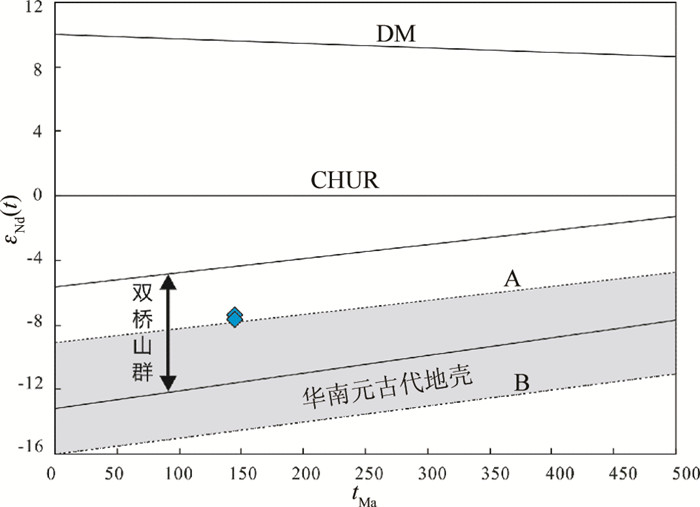
|
图 12 大湖塘似斑状白云母花岗斑岩的εNd(t)-t图 双桥山群εNd(t) 的演化数据来源于马长信和项新葵, 1993; 李献华, 1996; 张海祥等, 2000 Fig. 12 he εNd(t)-t diagram of the Dahutang porphyric-like muscovite granite The Shuangqiaoshan Group data after Ma and Xiang (1993), Li (1996), Zhang et al. (2000) |
九岭花岗岩体北临长江中下游成矿带,南边为十杭成矿带,这两个成矿带在燕山期也有大规模的岩浆活动,前人对这两个成矿带上燕山期花岗岩已经进行了较多的年代学和成岩构造背景的研究。长江中下游成矿带九瑞地区与Cu-Au-Mo矿相关的燕山晚期花岗闪长斑岩成岩年龄主要是在145Ma左右(Li et al., 2010; Yang et al., 2011b),大湖塘似斑状白云母花岗斑岩年龄144.2±1.3Ma与长江中下游九瑞成矿区的燕山晚期火成岩一致。十杭带南西段南岭地区含钨花岗岩的成岩年龄主要在150~160Ma (Zhu et al., 2008, 2009; Feng et al., 2012),这个年龄比九岭燕山期花岗岩的年龄老。而十杭带北东段(赣杭带) 燕山晚期火山侵入杂岩的成岩年龄主要集中在125~135Ma (Wong et al., 2009; Yang et al., 2011a, 2012; Jiang et al., 2011),这个年龄比九岭燕山期花岗岩的年龄年轻。尽管九瑞地区和十杭成矿带上燕山期花岗岩的年龄存在差异,但是这些燕山期花岗岩都被认为是在一个拉张的构造背景下形成的,这个减压拉伸的构造背景普遍存在于整个燕山期已得到诸多学者的证实(如Li, 2000; Zhou and Li, 2000; Zhou et al., 2006; Li and Li, 2007; Chen et al., 2008; Wong et al., 2009; Wang et al., 2011; Yang et al., 2012)。由此可见,位于九瑞地区和十杭成矿带之间的九岭燕山期花岗岩也应该在一个减压拉伸的环境下形成的。
4.5 岩体形成与成矿的关系许多研究均发现钨矿的形成与S型花岗岩有密切的关系(Guo et al., 2012; 徐克勤和程海, 1987; 张文兰等, 2006; 周新民, 2007)。钨是一种不相容性极强的亲石元素,在地幔中亏损,在地壳中富集,呈+6和+4两种价态,大多呈[WO4]2-形式存在(Ertel et al., 1996)。钨在现代地幔的平均含量是0.0083±0.0071×10-6(Arevalo and McDonough, 2008),在下地壳的含量为0.6×10-6,上地壳的含量为1.9×10-6,平均地壳含量为1.0×10-6(Rudnick and Gao, 2004)。本区中的花岗岩原岩是华南古老基底双桥山群中富泥质岩,钨倾向于富集在泥质岩石中,特别是含铁、锰、碳质的细碎沉积物,华南各类泥质岩石中具有最高的W、Sn、Sb、U等成矿元素丰度(鄢明才和迟清华, 1997)。在华南地区总的来看, 泥岩、页岩和板岩中钨含量高于砂岩,双桥山群中钨的含量到达11.82×10-6相对平均地壳富集11倍(刘英俊等, 1982),大湖塘似斑状白云母的3个样品中钨的含量变化范围(表 3):27.9×10-6~102×10-6,大约是平均地壳含量的28到102倍。其岩浆源区富泥质的双桥山群是含钨建造,岩石圈减薄拉伸以及地幔热扰动提供了成岩成矿的热源和通道,且通过对黑云母的研究可以发现F的含量很高(1.01%~1.22%, 表 1),虽然前人研究表明钨并不以氟、氯的络合物形式在热液中进行迁移(Wesolowski et al., 1984; Wood, 1990; Keppler and Wyllie, 1991),但氟化物的存在会使钨更容易进入硅酸盐熔体(Manning, 1984; Manning and Henderson, 1984; Keppler and Wyllie, 1991),而氟化物本身也优先进入岩浆(Webster, 1990; Xiong et al., 1998)。氟的存在可能提高了钨在富水岩浆中的溶解度,增加了钨在岩浆中的富集程度,延缓了含钨热液从岩浆中的分离(马东升, 2009)。
根据本区花岗岩中黑云母的电子探针成分分析结果,采用郑巧荣(1983)的过剩氧方法, 我们计算了大湖塘似斑状白云母花岗岩中黑云母的二价铁和三价铁。结果表明,黑云母的Fe3+/(Fe3++Fe2+) 比值为0.017~0.044(表 1),反映了较还原的岩浆环境。将计算结果投点于Fe3+-Fe2+-Mg2+的三元图解中(图 13),样品点均落在Fe2SiO4-SiO2-Fe3O4缓冲剂线上,显示了低的氧逸度环境。在高温还原条件下,钨呈现出亲铁性质,且温度越高,还原作用越强,钨在金属相中的富集程度越高(Bischoff and Palme, 1987; Wasson and Kallemeyn, 1988; Sylvester et al., 1990)。因此,大湖塘钨矿的形成与大湖塘似斑状白云母花岗岩浆的低氧逸度有关,它使钨富集在岩浆体系当中。
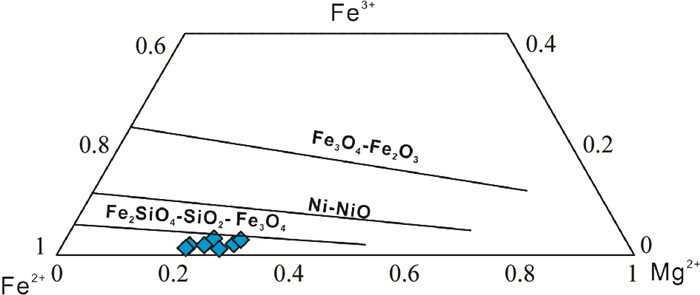
|
图 13 大湖塘似斑状白云母花岗斑岩黑云母Fe3+-Fe2+-Mg2+三元图解(底图据Wones and Eugster, 1965) Fig. 13 Plot of Fe3+-Fe2+-Mg2+ of biotites from the Dahutang porphyric-like muscovite granite (after Wones and Eugster, 1965) |
大湖塘似斑状白云母花岗岩岩浆与热液脉型的钨矿床的成矿作用紧密相关,主要体现在岩浆源区富含钨元素、岩浆低氧逸度及高氟的特征,使钨元素能够富集并且迁移。此外,丰成友等(2012b)报道了大湖塘矿区石门寺矿段和狮尾洞矿段辉钼矿Re-Os等时线年龄分别为143.7±1.2Ma和140.9±3.6Ma,与本文报道的似斑状白云母花岗岩的成岩年龄一致,进一步说明了两者的成因联系及成岩成矿的同时性。
5 结论本文利用LA-ICP-MS锆石U-Pb定年法测得大湖塘似斑状白云母成岩年龄为144.2±1.3Ma,表明九岭地区燕山期岩浆活动开始于侏罗纪和白垩纪的交接时段。岩相学、矿物化学以及岩石地球化学研究表明大湖塘似斑状白云母花岗岩属于强过铝质的S型花岗岩,锆饱和温度计计算结果表明该白云母花岗岩形成温度的上限为749~759℃。大湖塘似斑状白云母花岗岩的εNd(t) 值变化于-7.47~-7.78之间,两阶段模式年龄tDMC为1543~1568Ma。结合大湖塘似斑状白云母花岗岩的CaO/Na2O值都小于0.3,表明大湖塘似斑状白云母花岗岩的原岩很可能是来自于双桥山群中的富泥质岩石,双桥山群泥质岩富钨元素,且似斑状白云母花岗岩的高氟和低氧逸度的环境也有利于钨的富集和迁移,大湖塘似斑状白云母花岗岩与钨矿的形成有密切关系。九岭地区燕山期岩浆岩的年龄在南岭含钨花岗岩和赣杭带火山侵入杂岩的年龄之间,而和长江中下游九瑞地区燕山期岩浆岩的年龄相当,推测九岭地区燕山期的岩浆岩是在拉张的构造环境下形成的。
致谢 本文锆石U-Pb定年得到了武兵老师的帮助和指导,电子探针分析得到了张文兰教授的帮助和指导,野外地质工作得到赣西北地质大队的帮助和大力支持,两位审稿人提出了很好的修改建议,在此一并表示衷心的感谢。| [] | Abdel-Rahman AM. 1994. Nature of biotites from alkaline, calc-alkaline, and peraluminous magmas. Journal of Petrology, 35(2): 525–541. DOI:10.1093/petrology/35.2.525 |
| [] | Andersen T. 2002. Correction of common lead in U-Pb analyses that do not report 204Pb. Chemical Geology, 192(1-2): 59–79. DOI:10.1016/S0009-2541(02)00195-X |
| [] | Arevalo JR, McDonough WF. 2008. Tungsten geochemistry and implications for understanding the Earth's interior. Earth and Planetary Science Letters, 272(3-4): 656–665. DOI:10.1016/j.epsl.2008.05.031 |
| [] | Bischoff A, Palme H. 1987. Composition and mineralogy of refractory-metal-rich assemblages from a Ca, Al-rich inclusion in the Allende meteorite. Geochimica et Cosmochimica Acta, 51(10): 2733–2748. DOI:10.1016/0016-7037(87)90153-0 |
| [] | Bureau of Geology and Mineral Resources of Jiangxi Province. 1984. Regional Geology of Jiangxi Province. Beijing: Geological Publishing House. |
| [] | Chen CH, Lee CY, Shinjo R. 2008. Was there Jurassic paleo-Pacific subduction in South China? Constraints from 40Ar/39Ar dating, elemental and Sr-Nd-Pb isotopic geochemistry of the Mesozoic basalts. Lithos, 106: 83–92. DOI:10.1016/j.lithos.2008.06.009 |
| [] | Cheng YB, Tong X, Wu JD and Mo GP. 2010. Geochronology framework of the W-Sn mineralization granites in western South China and their geological significance. Acta Petrologica Sinica, 26(3): 809-818 (in Chinese with English abstract) |
| [] | Clarke DB. 1981. The mineralogy of peraluminous granites: A review. Canadian Mineralogist, 19(1): 3–17. |
| [] | Ertel WH, O'Neill SC, Dingwell DB, Spettel B. 1996. Solubility of tungsten in a haplobasaltic melt as a function of temperature and oxygen fugacity. Geochimica et Cosmochimica Acta, 60(7): 1171–1180. DOI:10.1016/0016-7037(96)00022-1 |
| [] | Feng CY, Xu JX, Zeng ZL, Zhang DQ, Qu WJ, She HQ, Li JW, Li DX, Du AD, Dong YJ. 2007. Zircon SHRIMP U-Pb and molybdenite Re-Os dating in Tianmenshan-Hongtaoling tungsten-tin ore field, southern Jiangxi Province, China, and its geological implication. Acta Geologica Sinica, 81(7): 952–963. |
| [] | Feng CY, Zeng ZL, Zhang DQ, Qu WJ, Du AD, Li DX, She HQ. 2011. SHRIMP zircon U-Pb and molybdenite Re-Os isotopic dating of the tungsten deposits in the Tianmenshan-Hongtaoling W-Sn ore field, southern Jiangxi Province, China, and geological implications. Ore Geology Reviews, 43(1): 8–25. DOI:10.1016/j.oregeorev.2011.04.006 |
| [] | Feng CY, Huang F, Zeng ZL, Qu WJ, Ding M. 2011. Isotopic chronology of Jiulongnao granite and Hongshuizhai greisens-type tungsten deposit in South Jiangxi Province. Journal of Jilin University (Earth Science Edition), 41(1): 111–121. |
| [] | Feng CY, Wang S, Zeng ZL, Zhang DQ, Li DX, She HQ. 2012a. Fluid inclusion and chronology studies of Baxiannao mineralized fractured zone-type tungsten polymetallic deposit, southern Jiangxi Province, China. Acta Petrologica Sinica, 28(1): 52–64. |
| [] | Feng CY, Zhang DQ, Xiang XK, Li DX, Liu JN, Xiao Y, Qu HY. 2012b. Re-Os isotopic dating of molybdenite from the Dahutang tungsten deposit in northwestern Jiangxi Province and its geological implication. Acta Petrologica Sinica, 28(12): 3858–3868. |
| [] | Feng ZH, Wang CZ, Zhang MH, Liang JC. 2012. Unusually dumbbell-shaped Guposhan-Huashan twin granite plutons in Nanling Range of south China: Discussion on their incremental emplacement and growth mechanism. Journal of Asian Earth Sciences, 48(2): 9–23. |
| [] | Gao JF, Lu JJ, Lai MY, Lin YP, Pu W. 2003. Analysis of trace elements in rock samples using HR-ICP-MS. Journal of Nanjing University (Natural Science), 39(6): 844–850. |
| [] | Gao LZ, Yang MG, Ding XZ, Liu YX, Liu X, Ling LH, Zhang CH. 2008. SHRIMP U-Pb zircon dating of tuff in the Shuangqiaoshan and Heshangzhen groups in South China: Constraints on the evolution of the Jiangnan Neoproterozoic orogenic belt. Geological Bulletin of China, 27(10): 1744–1751. |
| [] | Gao LZ, Huang ZZ, Ding XZ, Liu YX, Pang JF, Zhang CH. 2012. Zircon SHRIMP U-Pb dating of Xiushui and Majianqiao formations in northwestern Jiangxi Province. Geological Bulletin of China, 31(7): 1086–1093. |
| [] | Guo CL, Chen YC, Zeng ZL, Lou FS. 2012. Petrogenesis of the Xihuashan granites in southeastern China: Constraints from geochemistry and in-situ analyses of zircon U-Pb-Hf-O isotopes. Lithos, 148: 209–227. DOI:10.1016/j.lithos.2012.06.014 |
| [] | Hua RM, Li GL, Zhang WL, Hu DQ, Chen PR, Chen WF, Wang XD. 2010. A tentative discussion on differences between large-scale tungsten and tin mineralizations in South China. Mineral Deposits, 29(1): 9–23. |
| [] | Jackson SE, Pearson NJ, Griffin WL, Belousova EA. 2004. The application of laser ablation-inductively coupled plasma-mass spectrometry to in situ U-Pb zircon geochronology. Chemical Geology, 211(1-2): 47–69. DOI:10.1016/j.chemgeo.2004.06.017 |
| [] | Jiang YH, Zhao P, Zhou Q, Liao SY, Jin GD. 2011. Petrogenesis and tectonic implications of Early Cretaceous S-and A-type granites in the northwest of the Gan-Hang rift, SE China. Lithos, 121(1-4): 55–73. DOI:10.1016/j.lithos.2010.10.001 |
| [] | Keppler H, Wyllie PJ. 1991. Partitioning of Cu, Sn, Mo, W, U, and Th between melt and aqueous fluid in the systems haplogranite-H2O-HCl and haplogranite-H2O-HF. Contributions to Mineralogy and Petrology, 109(2): 139–150. DOI:10.1007/BF00306474 |
| [] | Li XH and McCulloch MT. 1996. Nd isotopic evolution of sediments from the southern margin of the Yangtze Block and its tectonic significance. Acta Petrologica Sinica, 12(3): 359-369 (in Chinese with English abstract) |
| [] | Li XH. 2000. Cretaceous magmatism and lithospheric extension in southeast China. Journal of Asian Earth Sciences, 18(3): 293–305. DOI:10.1016/S1367-9120(99)00060-7 |
| [] | Li XH, Li WX, Wang XC, Li QL, Liu Y, Tang GQ, Gao YY, Wu FY. 2010. SIMS U-Pb zircon geochronology of porphyry Cu-Au-(Mo) deposits in the Yangtze River Metallogenic Belt, eastern China: Magmatic response to early Cretaceous lithospheric extension. Lithos, 119(3-4): 427–438. DOI:10.1016/j.lithos.2010.07.018 |
| [] | Li ZX, Li XH. 2007. Formation of the 1300 km-wide intracontinental orogen and postorogenic magmatic province in Mesozoic South China: A flat-slab subduction model. Geology, 35(2): 179–182. DOI:10.1130/G23193A.1 |
| [] | Liew TC, Hofmann AW. 1988. Precambrian crustal components, plutonic associations, plate environment of the Hercynian Fold Belt of central Europe: Indications from a Nd and Sr isotopic study. Contributions to Mineralogy and Petrology, 98(2): 129–138. DOI:10.1007/BF00402106 |
| [] | Lin L, Yu ZZ, Luo XH, Ding SH. 2006a. The metallogenic prognosis of Dahutang tungsten ore field in Jiangxi. Journal of East China Institute of Technology, 3(S1): 139–142. |
| [] | Lin L, Zhan GL, Yu XP. 2006b. Geological characteristics and ore-search prospect of Dahutang tungsten (tin) orefield in Jiangxi. Resources Survey & Environment, 27(1): 25–32. |
| [] | Liu YJ, Li ZL, Ma DS. 1982. The geochemical studies of tungsten-bearing formation in South China. Science in China (Series B)(10): 939–950. |
| [] | Ludwig KR. 2003. Isoplot 3.00 User's Manual: A Geochronological Toolkit for Microsoft Excel. Berkeley Geochronological Center, Special Publication No. 4a: 1-70 |
| [] | Ma CX. 1991. Sm-Nd isotopic studies and its geological significance of Zhanggongshan Group in the northeastern Jiangxi. Chinese Science Bulletin(19): 1518–1519. |
| [] | Ma CX, Xiang XK. 1993. Preliminary study of the Nd isotopic model ages of the Precambrian metamorphic strata in northeastern Jiangxi Province. Scientia Geologica Sinica, 28(2): 145–150. |
| [] | Ma DS. 2009. Progress in research on geochemistry of tungsten. Geological Journal of China Universities, 15(1): 19-34 (in Chinese with English abstract) |
| [] | Manning DAC. 1984. Volatile control of tungsten partitioning in granitic melt-vapour systems. Transactions of the Institute of Mining and Metallurgy, 93: B185–B189. |
| [] | Manning DAC, Henderson P. 1984. The behaviour of tungsten in granitic melt-vapour systems. Contributions to Mineralogy and Petrology, 86(3): 286–293. DOI:10.1007/BF00373674 |
| [] | McDonough WF, Sun SS. 1995. The composition of the Earth. Chemical Geology, 120(3-4): 223–253. DOI:10.1016/0009-2541(94)00140-4 |
| [] | Mei YW. 1987. Relation between evolution of granite and mineralization of vein-type tungsten deposits of Xihuashan, Jiangxi Province. Acta Petrologica Sinica, 11(4): 10–20. |
| [] | Miller CF, Mcdowell SM, Mapes RW. 2003. Hot and cold granites? Implications of zircon saturation temperatures and preservation of inheritance. Geology, 31(6): 529–532. DOI:10.1130/0091-7613(2003)031<0529:HACGIO>2.0.CO;2 |
| [] | Pu W, Gao JF, Zhao KD, Ling HF, Jiang SY. 2005. Separation method of Rb-Sr, Sm-Nd using DCTA and HIBA. Journal of Nanjing University (Natural Sciences), 41(4): 445–450. |
| [] | Rieder M, Cavazzini G, D'Yakonov YS, Frank-Kamenetskii VA, Gottardi G, Guggenheim S, Koval PV, Müeller G, Neiva AMR, Radoslovich EW, Robert JL, Sassi FP, Takeda H, Weiss Z, Wones DR. 1998. Nomenclature of the micas. Canadian Mineralogist, 36: 905–912. |
| [] | Rudnick RL and Gao S. 2004. Composition of the continental crust. In: Rudnick RL (ed.). Treatise on Geochemistry. New York: Elsevier, 3: 1-64 |
| [] | Shu XJ, Wang XL, Sun T, Xu XS, Dai MN. 2011. Trace elements, U-Pb ages and Hf isotopes of zircons from Mesozoic granites in the western Nanling Range, South China: Implications for petrogenesis and W-Sn mineralization. Lithos, 127(3-4): 468–482. DOI:10.1016/j.lithos.2011.09.019 |
| [] | Sun T, Chen PR, Zhou XM, Wang RC, Wang ZC. 2002. Strongly peraluminous granites in eastern Nanling Mountains, China: Study on muscovites. Geological Review, 48(5): 518–525. |
| [] | Sun T, Zhou XM, Chen PR, Zhou HY, Li HM, Wang ZC, Shen WZ. 2003. Mesozoic strong peraluminous granite and its tectonic significance in the eastern Nanling Mountains, China. Science in China (Series D), 33(12): 1209–1218. |
| [] | Sylvester PJ, Ward BJ, Grossman L, Hutcheon ID. 1990. Chemical compositions of siderophile element-rich opaque assemblages in an Allende inclusion. Geochimica et Cosmochimica Acta, 54(12): 3491–3508. DOI:10.1016/0016-7037(90)90300-A |
| [] | Sylvester PJ. 1998. Post-collisional strongly peraluminous granites. Lithos, 45(1-4): 29–44. DOI:10.1016/S0024-4937(98)00024-3 |
| [] | Van Achterbergh E, Ryan CG, Jackson SE and Griffin WL. 2001. Data reduction software for LA-ICP-MS. In: Sylvester P (ed.). Laser-ablation-ICP-MS in the Earth Sciences: Principles and Applications. Ottawa: Mineralogical Association of Canada, 239-243 |
| [] | Wang FY, Ling MX, Ding X, Hu YH, Zhou JB, Yang XY, Liang HY, Fan WM, Sun WD. 2011. Mesozoic large magmatic events and mineralization in SE China: Oblique subduction of the Pacific plate. International Geology Review, 53(5-6): 704–726. DOI:10.1080/00206814.2010.503736 |
| [] | Wang XD, Ni P, Jiang SY, Huang JB, Sun LQ. 2008. Fluid inclusion study on the Piaotang tungsten deposit, southern Jiangxi province, China. Acta Petrologica Sinica, 24(9): 2163–2170. |
| [] | Wang XD, Ni P, Jiang SY, Zhao KD, Wang TG. 2010. Origin of ore-forming fluid in the Piaotang tungsten deposit in Jiangxi Province: Evidence from helium and argon isotopes. Chinese Science Bulletin, 55(7): 628–634. DOI:10.1007/s11434-009-0416-8 |
| [] | Wang XL, Zhou JC, Qiu JS, Gao JF. 2004. Petrogenesis of Neoproterozoic peraluminous granites from northeastern Hunan Province: Chronological and geochemical constraints. Geological Review, 50(1): 65–76. |
| [] | Wang XL, Zhao GC, Zhou JC, Liu YS, Hu J. 2008. Geochronology and Hf isotopes of zircon from volcanic rocks of the Shuangqiaoshan Group, South China: Implications for the Neoproterozoic tectonic evolution of the eastern Jiangnan orogen. Gondwana Research, 14(3): 355–367. DOI:10.1016/j.gr.2008.03.001 |
| [] | Wasson JT, Kallemeyn GW. 1988. Compositions of chondrites. Philosophical Transactions of the Royal Society of London, 325(1587): 535–544. DOI:10.1098/rsta.1988.0066 |
| [] | Watson EB, Harrison TM. 1983. Zircon saturation revisited: Temperature and composition effects in a variety of crustal magma types. Earth and Planetary Science Letters, 64(2): 295–304. DOI:10.1016/0012-821X(83)90211-X |
| [] | Webster JD. 1990. Partitioning of F between H2O and CO2 fluids and topaz rhyolite melt. Contributions to Mineralogy and Petrology, 104(4): 424–438. DOI:10.1007/BF01575620 |
| [] | Wesolowski D, Drummond SE, Mesmer RE, Ohmoto H. 1984. Hydrolysis equilibria of tungsten (VI) in aqueous sodium chloride solutions to 300. degree.c. Inorganic Chemistry, 23(8): 1120–1132. |
| [] | White AJR, Chappell BW. 1977. Ultrametamorphism and granitoid genesis. Tectonophysics, 43(1-2): 7–22. DOI:10.1016/0040-1951(77)90003-8 |
| [] | Wones DR, Eugster HP. 1965. Stability of biotite: Experiment, theory and application. American Mineralogist, 50: 1228–1272. |
| [] | Wong J, Sun M, Xing GF, Li XH, Zhao GC, Wong K, Yuan C, Xia XP, Li LM, Wu FY. 2009. Geochemical and zircon U-Pb and Hf isotopic study of the Baijuhuajian metaluminous A-type granite: Extension at 125~100Ma and its tectonic significance for South China. Lithos, 112(3-4): 289–305. DOI:10.1016/j.lithos.2009.03.009 |
| [] | Wood SA. 1990. Do tungsten chloride complexes contribute to the genesis of hydrothermal tungsten deposits? Goldschmidt Conference, Baltimore, Maryland, Abstract Volume, 92 |
| [] | Xiong XL, Zhao ZH, Zhu JC, Bing R, Lai MY. 1998. Partitioning of F between aqueous fluids and albite granite melt and its petrogenetic and metallogenetic significance. Chinese Journal of Geochemistry, 17(4): 303–310. DOI:10.1007/BF02837981 |
| [] | Xu KQ and Chen H. 1987. Tectonic environment for the formation of tungsten deposits in China. Contributions to Geology and Mineral Resources Research, 2(3): 1-7 (in Chinese with English abstract) |
| [] | Xu JX, Zeng ZL, Wang DH, Chen ZH, Liu SB, Wang CH, Ying LJ. 2008. A new type of tungsten deposit in southern Jiangxi and the new model of "Five Floors + Basement" for prospecting. Acta Geologica Sinica, 82(7): 880–887. |
| [] | Yan CM and Chi QH. 1997. The Chemical Composition of the Eastern China Continental Crust and Rocks. Beijing: Science Press, 1-171 (in Chinese with English abstract) |
| [] | Yang MG, Wu GA, Zhong NC. 1988. Mesoproterozoic to Late Proterozoic stratigraphic division, characteristics of sedimentary formations and tectonic evolution in South China. Jiangxi Geology, 2(2): 112–121. |
| [] | Yang SY, Jiang SY, Jiang YH, Zhao KD, Fan HH. 2011a. Geochemical, zircon U-Pb dating and Sr-Nd-Hf isotopic constraints on the age and petrogenesis of an Early Cretaceous volcanic-intrusive complex at Xiangshan, Southeast China. Mineralogy and Petrology, 101(1-2): 21–48. DOI:10.1007/s00710-010-0136-4 |
| [] | Yang SY, Jiang SY, Li L, Sun Y, Sun MZ, Bian LZ, Xiong YG, Cao ZQ. 2011b. Late Mesozoic magmatism of the Jiurui mineralization district in the Middle-Lower Yangtze River Metallogenic Belt, eastern China: Precise U-Pb ages and geodynamic implications. Gondwana Research, 20(4): 831–843. DOI:10.1016/j.gr.2011.03.012 |
| [] | Yang SY, Jiang SY, Zhao KD, Jiang YH, Ling HF, Luo L. 2012. Geochronology, geochemistry and tectonic significance of two Early Cretaceous A-type granites in the Gan-Hang Belt, Southeast China. Lithos, 150: 155–170. DOI:10.1016/j.lithos.2012.01.028 |
| [] | Zhang HY, Sun DZ, Zhu BQ, Tu XL. 2000. Pb, Nd isotopic study of Proterozoic metamorphic sediments in north Jiangxi and its tectonic significance. Regional Geology of China, 19(1): 66–71. |
| [] | Zhang WL, Hua RM, Wang RC, Chen PR, Li HM. 2006. New dating of the Dajishan granite and related tungsten mineralization in southern Jiangxi. Acta Geologica Sinica, 80(7): 956–963. |
| [] | Zhang YX. 1982. Geological characteristics and origin of Yangchuling porphyry W-Mo-deposit. Geochimica, (2): 122-132 (in Chinese with English abstract) |
| [] | Zheng QR. 1983. Caculation of the Fe3+ and Fe2+ contents in silicates and Fe-Ti oxides from EMPA data. Acta Mineralogica Sinica, (1): 55-62 (in Chinese with English abstract) |
| [] | Zhong YF, Ma CQ, She ZB, Lin GC, Jin XH, Wang RJ, Yang QG, Liu Q. 2005. SHRIMP U-Pb zircon geochronology of the Jiuling granitic complex batholith in Jiangxi Province. Earth Science, 30(6): 685–691. |
| [] | Zhou XM, Sun T, Shen W, Niu YL. 2006. Petrogenesis of Mesozoic granitoids and volcanic rocks in South China: A response to tectonic evolution. Episodes, 29(1): 26–33. |
| [] | Zhou XM. 2007. The lithosphere Dynamical Evolution of Late Mesozoic Granites in Nanling Area. Beijing: Science Press. |
| [] | Zhou ZX. 1988. Chemical characteristics of mafic mica in intrusive rocks and its geological meaning. Acta Petrologica Sinica, 4(3): 63-73 (in Chinese with English abstract) |
| [] | Zhou XM, Li WX. 2000. Origin of Late Mesozoic igneous rocks in southeastern China: Implications for lithosphere subduction and underplating of mafic magmas. Tectonophysics, 326: 269–287. DOI:10.1016/S0040-1951(00)00120-7 |
| [] | Zhu JC, Chen J, Wang RC, Lu JJ, Xie L. 2008. Early Yanshanian NE trending Sn/W-bearing A-type granites in the western-middle part of the Nanling Mts Region. Acta Metallurgica Sinica, 14(4): 474–484. |
| [] | Zhu JC, Wang RC, Xie CF, Zhang WL, Zhao KD, Xie L, Yang C, Che XD. 2009. Zircon U-Pb geochronological framework of Qitianling granite batholith, middle part of Nanling Range, South China. Science in China (Series D), 52(9): 1279–1294. DOI:10.1007/s11430-009-0154-4 |
| [] | 程彦博, 童祥, 武俊德, 莫国培. 2010. 华南西部地区晚中生代与W-Sn矿有关花岗岩的年代学格架及地质意义. 岩石学报, 26(3): 809–818. |
| [] | 丰成友, 许建祥, 曾载淋, 张德全, 屈文俊, 佘宏全, 李进文, 李大新, 杜安道, 董英君. 2007. 赣南天门山-红桃岭钨锡矿田成岩成矿时代精细测定及其地质意义. 地质学报, 81(7): 952–963. |
| [] | 丰成友, 黄凡, 曾载淋, 屈文俊, 丁明. 2011. 赣南九龙脑岩体及洪水寨云英岩型钨矿年代学. 吉林大学学报(地球科学版), 41(1): 111–121. |
| [] | 丰成友, 王松, 曾载淋, 张德全, 李大新, 佘宏全. 2012a. 赣南八仙脑破碎带型钨锡多金属矿床成矿流体和年代学研究. 岩石学报, 28(1): 52–64. |
| [] | 丰成友, 张德全, 项新葵, 李大新, 刘建楠, 肖晔, 瞿泓滢. 2012b. 赣西北大湖塘钨矿床辉钼矿Re-Os同位素定年及其意义. 岩石学报, 28(12): 3858–3868. |
| [] | 高剑峰, 陆建军, 赖鸣远, 林雨萍, 濮巍. 2003. 岩石样品中微量元素的高分辨率等离子质谱分析. 南京大学学报, 39(6): 844–850. |
| [] | 高林志, 杨明桂, 丁孝忠, 刘燕学, 刘训, 凌联海, 张传恒. 2008. 华南双桥山群和河上镇群凝灰岩中的锆石SHRIMP U-Pb年龄--对江南新元古代造山带演化的制约. 地质通报, 27(10): 1744–1751. |
| [] | 高林志, 黄志忠, 丁孝忠, 刘燕学, 庞健峰, 张传恒. 2012. 赣西北新元古代修水组和马涧桥组SHRIMP锆石U-Pb年龄. 地质通报, 31(7): 1086–1093. |
| [] | 华仁民, 李光来, 张文兰, 胡东泉, 陈培荣, 陈卫锋, 王旭东. 2010. 华南钨和锡大规模成矿作用的差异及其原因初探. 矿床地质, 29(1): 9–23. |
| [] | 江西省地质矿产局. 1984. 江西省区域地质志. 北京: 地质出版社. |
| [] | 李献华, McCullochMT. 1996. 扬子南缘沉积岩的Nd同位素演化及其大地构造意义. 岩石学报, 12(3): 359–369. |
| [] | 林黎, 余忠珍, 罗小洪, 丁少辉. 2006a. 江西大湖塘钨矿田成矿预测. 东华理工学院学报, 3(增): 139–142. |
| [] | 林黎, 占岗乐, 喻晓平. 2006b. 江西大湖塘钨(锡) 矿田地质特征及远景分析. 资源调查与环境, 27(1): 25–32. |
| [] | 刘英俊, 李兆麟, 马东升. 1982. 华南含钨建造的地球化学研究. 中国科学(B辑)(10): 939–950. |
| [] | 马长信. 1991. 赣东北古元古宙障公山群的钐钕同位素年龄新成果及其地质意义. 科学通报(19): 1518–1519. |
| [] | 马长信, 项新葵. 1993. 赣东北前寒武纪变质地层钦模式年龄初步研究. 地质科学, 28(2): 145–150. |
| [] | 马东升. 2009. 钨的地球化学研究进展. 高校地质学报, 15(1): 19–34. |
| [] | 梅勇文. 1987. 江西西华山花岗岩的演化与脉钨矿床的成矿关系. 岩石学报, 11(4): 10–20. |
| [] | 濮巍, 高剑峰, 赵葵东, 凌洪飞, 蒋少涌. 2005. 利用DCTA和HIBA快速有效分离Rb-Sr、Sm-Nd的方法. 南京大学学报(自然科学版), 41(4): 445–450. |
| [] | 孙涛, 陈培荣, 周新民, 王汝成, 王志成. 2002. 南岭东段强过铝质花岗岩中白云母研究. 地质评论, 48(5): 518–525. |
| [] | 孙涛, 周新民, 陈培荣, 周红英, 李惠民, 王志成, 沈渭洲. 2003. 南岭东段中生代强过铝花岗岩成因及其大地构造意义. 中国科学(D辑), 33(12): 1209–1218. |
| [] | 王旭东, 倪培, 蒋少涌, 黄建宝, 孙立强. 2008. 赣南漂塘钨矿流体包裹体研究. 岩石学报, 24(9): 2163–2170. |
| [] | 王孝磊, 周金城, 邱检生, 高剑峰. 2004. 湘东北新元古代强过铝花岗岩的成因:年代学和地球化学证据. 地质评论, 50(1): 65–76. |
| [] | 徐克勤, 程海. 1987. 中国钨矿形成的大地构造背景. 地质找矿论丛, 2(3): 1–7. |
| [] | 许建祥, 曾载淋, 王登红, 陈郑辉, 刘善宝, 王成辉, 应立娟. 2008. 赣南钨矿新类型及"五层楼+地下室"找矿模型. 地质学报, 82(7): 880–887. |
| [] | 鄢明才, 迟清华. 1997. 中国东部地壳与岩石的化学组成. 北京:科学出版社: 1–171. |
| [] | 杨明桂, 吴安国, 钟南昌. 1988. 华南中晚元古代地层划分、沉积建造特征及其地壳构造演化. 江西地质, 2(2): 112–121. |
| [] | 张海祥, 孙大中, 朱炳泉, 涂湘林. 2000. 赣北元古代变质沉积岩的铅钕同位素特征. 中国区域地质, 19(1): 66–71. |
| [] | 张文兰, 华仁民, 王汝成, 陈培荣, 李惠民. 2006. 赣南大吉山花岗岩成岩与钨矿成矿年龄的研究. 地质学报, 80(7): 956–963. |
| [] | 张玉学. 1982. 阳储岭斑岩钨钼矿床地质地球化学特征及其成因探讨. 地球化学(2): 122–132. |
| [] | 郑巧荣. 1983. 由电子探针分析值计算Fe3+和Fe2+. 矿物学报(1): 55–62. |
| [] | 钟玉芳, 马昌前, 佘振兵, 林广春, 续海金, 王人镜, 杨坤光, 刘强. 2005. 江西九岭花岗岩类复式岩基锆石SHRIMP U-Pb年代学. 地球科学, 30(6): 685–691. |
| [] | 周新民. 2007. 南岭地区晚中生代花岗岩成因与岩石圈动力学演化. 北京:科学出版社: 1–69. |
| [] | 周作侠. 1988. 侵入岩的镁铁云母化学成分特征及其地质意义. 岩石学报, 4(3): 63–73. |
 2012, Vol. 28
2012, Vol. 28










